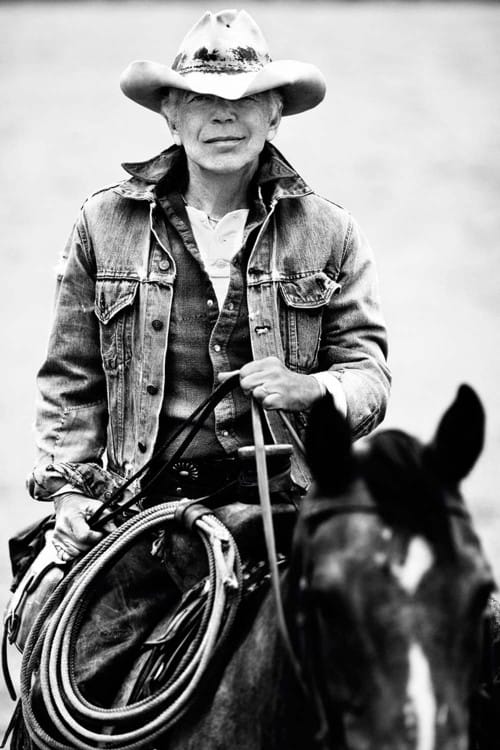
Image courtesy of Ralph Lauren
Ralph Lauren steps down as Chief Executive of his luxury fashion brand. He will be replaced by Stefan Larsson, the president of Old Navy. However, Mr Lauren will continue as Executive Chairman and Chief Creative Officer. Mr Larsson will report to Mr Lauren who will remain at the heart of the company he founded in 1967. The designer first met Justine Picardie two years ago at his home in the Hamptons…
The road to Montauk from Manhattan is slow on a summer Saturday, winding through the Hamptons where the rich escape from the sweltering city; past the billionaires’ beachfront estates, in which rap stars and new-money moguls relax alongside old-school WASPs. Any visitor who happens to be an F Scott Fitzgerald fan might begin to wonder about the possible location of Jay Gatsby’s mansion, with its Normandy turrets and French Gothic library; and it is tempting for a romantic such as myself to imagine the man I am on my way to visit as a latter-day Gatsby. As it happens, it was Ralph Lauren who designed Robert Redford’s clothes in the 1974 film adaption of The Great Gatsby; but beyond that, there are other suggestive parallels. Just as Fitzgerald’s hero is the epitome of a self-made American, the child of a poor immigrant family, who changes his name from James Gatz to Jay Gatsby, so Ralph Lauren was born Ralph Lifshitz in 1939, the youngest son of Jewish immigrants to New York, who had left the oppression of Eastern Europe in search of a better life.
If it takes one extraordinary star truly to interpret another, then perhaps Oprah Winfrey’s description of the designer’s global success is the most astute. ‘Ralph Lauren sells much more than fashion,’ she has observed. ‘He sells the life you’d like to lead. To own a creation of Ralph Lauren’s… is to savour a taste of the American dream… More important, he has elevated what Americans see as possible for ourselves by offering a snapshot of a storybook lifestyle that somehow feels attainable.’
The snapshot that I am seeing today is at his Montauk beach house, with a view across the pale sand towards the ocean, stretching out to the limitless blue sky. But it turns out not to be a Gatsby castle (though he does have one of those, in New York state, along with a sleek Manhattan duplex and an elegant Caribbean villa at Montego Bay); rather, a low-lying Frank Lloyd Wright-inspired building that is hidden from prying eyes. It is beautiful – with a cedar shingled roof, pristine white walls and the original wooden floors; fresh white linen upholstery, and a coffee table arranged with illustrated books (including his wife Ricky’s volumes of recipes and photographs documenting their life in the Hamptons and at their Colorado ranch, and another of his celebrated classic-car collection). The family are in residence this weekend: Ralph and Ricky (who married in 1964), their daughter Dylan (the owner of the Dylan’s Candy Bar stores in New York, East Hampton, Miami and LA), their middle child, David (executive vice-president of global advertising, marketing and communications at Ralph Lauren), and his wife Lauren, the niece of former president George W Bush. (Their oldest son, Andrew, a film producer, will also be joining them.) The effect to a jet-lagged incomer is of walking into a Ralph Lauren advertisement featuring a golden-tanned clan, with warm smiles and clear eyes; indeed, the family starred as themselves in early ad campaigns, as the authentic embodiment of the world of Ralph Lauren.
Today, the founder of the brand is looking exactly as you would expect: silver-haired, tanned, trim in a black poloneck and khaki cotton shorts of his own design, with a Ralph Lauren Safari watch that could be vintage but is in fact new. His voice is soft, his manner gentle; he seems entirely himself, while also responsive to others, in a way that rich and famous men rarely are (which makes me think of Gatsby again: ‘If personality is an unbroken series of successful gestures, then there was something gorgeous about him, some heightened sensitivity to the promises of life, as if he were related to one of those intricate machines that register earthquakes ten thousand miles away’).
The catalyst for our meeting is his latest philanthropic project, one more in a long line of enormously generous and wide-ranging donations: amongst others, to establish a breast-cancer clinic in Harlem, and the $10 million he contributed towards the restoration of the original Star-Spangled Banner in Washington. His new commitment is to refurbish and modernise the Ecole Nationale Supérieure des Beaux-Arts in Paris, France’s national school of fine arts (past students include Henri Matisse, Claude Monet and Hubert de Givenchy). It is not Lauren’s style to boast – so he makes no mention that he was awarded the Chevalier de la Légion d’Honneur in 2010 – but he does talk fondly of Paris, where he restored a 17th-century mansion on Boulevard Saint-Germain that is now home to the brand’s European flagship. ‘I always loved the way Paris looked,’ he says, ‘and I think I was the first American designer in Europe. But my real romance happened when I opened the store on the Left Bank, and I felt like I loved the building, I loved being there. It was a lot of work, the building was a mess, but we returned it to its original beauty.’
The idea of original beauty – authentic, untainted, genuinely desirable – crops up regularly in our conversation; and perhaps it goes back all the way to Lauren’s childhood in the Bronx. His father, Frank, was from Pinsk (in what is now Belarus), a housepainter who was also an artist. ‘He was a very romantic man,’ says Lauren. ‘He used to play the mandolin and the violin and the piano by ear. And somewhere along the line he learnt how to do decoration – he’d do murals on the wall, and he also did synagogues and churches, and decorated the ceilings way up on high ladders.’ Ralph, the youngest of four (he has two older brothers, Jerry, who still works with him, and Lenny, who is seven years his senior; and a sister called Thelma), remembers his father taking him to the Metropolitan Museum of Art in New York to look at the paintings. Afterwards, inspired by these masterpieces, Frank would copy them; and he also learnt to do faux marble and wood effects with paint. But Ralph’s idea of beauty was coming from other sources; not traditional art, whether his father’s copies or museum originals, but Hollywood movies, which he watched at the local cinema every weekend. ‘I was in love with Rita Hayworth,’ he says, ‘she was like the girl next-door. And when she dances with Fred Astaire, she’s so sweet and delicate, and so beautiful it made my heart ache.’ As for the real girl next-door: ‘She was called Harriet, and was a little older than me. I don’t think she even paid attention to me, but I used to make her bracelets out of the wire that came around the bottles of milk…’ But, above all: ‘Movies had a very strong effect; movies were very much a part of your life when you were a kid.’
At 16, like his brother Jerry, he changed his name from Lifshitz to Lauren, ‘after Lauren Bacall’ (another New Yorker of Jewish-immigrant stock, who also changed her name, from Betty Joan Perske). ‘I wasn’t doing it to be pretentious,’ says Lauren. ‘I was a kid in school, my brothers had the same issue – you go to a public school crowded with all kinds of kids and they’d hear the name and say, “Is that shit? What’s in that name?” And they would make fun of the name, so every time I got up I cringed. Fortunately, I was a cool kid so I got through it, but inside I didn’t like it, it was very upsetting.’
Yet, with the perspective of age, he now says he sometimes regrets changing his name. ‘Because I believe in authenticity, it seems inauthentic to have changed your name. And I don’t like it to be an issue, so when people write about it, it tilts what I’m truly about.’ By this, he is referring to the lazy line, often trotted out in profiles of Lauren over the four decades of his fame, that he changed his name in a bid to become a WASP. According to this somewhat patronising analysis, the same impetus was behind his early job at Brooks Brothers, and his choice of a name for his fledgling company, Polo Ralph Lauren (after all, what business did a poor Jewish boy have in dreaming of such a distinctively aristocratic sport?) But that reductive approach ignores the more intriguing truth of how, and why, Ralph Lifshitz became one of the richest men in America, with a brand that is sufficiently desirable to be worn by British royalty (Princess Diana was a fan, and so are her sons) and the East Coast upper classes that his son has married into. You don’t get that far with fakery; on the contrary, Ralph Lauren’s success – like that of Coco Chanel (with whom he has more than a little in common) and the Hollywood pioneers (many of them Jewish) – is in part attributable to his capacity to inspire the dreams in others that he already believes in himself.
And again, like Chanel and her Hollywood contemporaries, Lauren is a great storyteller, who understands the transforming power of his tales. Indeed, he tends to see his fashion collections as filmic narratives. ‘When someone comes up to me at the end of the show and they say, “Oh, I love that dress, that gown, that shirt,” I say, “Well, what about the rest?” I never look at it simply as clothes. I know editors are coming to write about the new fashion, but I’m not about the new fashion. I’m about the story, and within that story I know that I have to do something new, something that makes you say, “Oh, wow, I love that.”’
And in doing so, his primary impetus has been to create stories that he loves, rather than trying to second-guess the market. His imagination has ranged from the American prairies to African safaris; from Grace Kelly evening gowns to Sante Fe suedes – and, remarkably, to blend these not into pastiches or costume dramas, but something recognisably his own. ‘I didn’t go into what I was doing to copy, or to be anyone else but myself,’ he says, with quiet yet passionate conviction. ‘I found something that touched the nerve for me all the time… I’ve always believed in timelessness, I believe in longevity, and that’s very important to me. It’s not a trend, it’s not a moment; it’s life. And it’s a dream life, it’s a wonderful life, it’s not fake, it’s not meant to be pretentious, it’s not meant to be, “Let me show you a way to live,” and have you look like a cowboy. It’s, “Let me show you what I see, let me make you love this, let me tell you the story.” And so far I’ve been mesmerised by Indians and cowboys, by Scotland, and old saddles, tweeds, and boots and gloves and leathers, and motorcycles, John Travolta, whoever it is, I have responded.’
Little wonder, then, that the world still responds in turn to Ralph Lauren: the mythmaker, yet also a true believer. For, in an era when so much looks uncertain, how reassuring to find a man – and a brand – with such heartfelt commitment and faith.
Via: Harper’s BAZAAR UK



